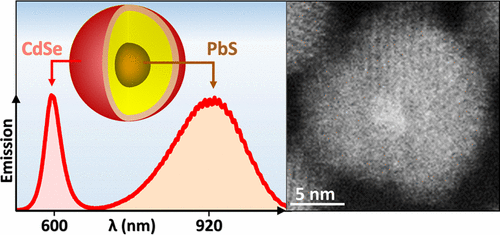当前位置:
X-MOL 学术
›
Chem. Mater.
›
论文详情
Our official English website, www.x-mol.net, welcomes your feedback! (Note: you will need to create a separate account there.)
Double-Well Colloidal Nanocrystals Featuring Two-Color Photoluminescence
Chemistry of Materials ( IF 8.6 ) Pub Date : 2017-09-15 00:00:00 , DOI: 10.1021/acs.chemmater.7b02585 Natalia Razgoniaeva 1 , Mingrui Yang 1 , Cooper Colegrove 1 , Natalia Kholmicheva 1 , Pavel Moroz 1 , Holly Eckard 1 , Abigail Vore 1 , Mikhail Zamkov 1
Chemistry of Materials ( IF 8.6 ) Pub Date : 2017-09-15 00:00:00 , DOI: 10.1021/acs.chemmater.7b02585 Natalia Razgoniaeva 1 , Mingrui Yang 1 , Cooper Colegrove 1 , Natalia Kholmicheva 1 , Pavel Moroz 1 , Holly Eckard 1 , Abigail Vore 1 , Mikhail Zamkov 1
Affiliation

|
Ratiometric sensing strategy relies on the ratio of the two photoluminescence (PL) signals originating from the same nano-object for detecting the changes in the surrounding media. Recently, such dual-color emission has been demonstrated in semiconductor colloids, where the PL signal from a quantum-confined domain was complemented with the secondary emission from transition metal ions or a bulk-like structure. Here, we report on the development of dual-color nanocrystal colloids featuring a combination of two quantum-confined emitters within the same nano-object. The reported morphology relies on double-well core/barrier/shell arrangement, where zero-dimensional excitons of the core component (PbS) can coexist with two-dimensional excitons of the shell domain (CdSe). As a result, the core and shell emission bands can be independently tuned across 880–1500 nm and 600–650 nm spectral windows, respectively. A CdS potential barrier at the PbS/CdSe interface was designed to suppress the energy and charge diffusion between the two domains allowing both emission bands to exhibit quantum yields over 10%. Fabricated colloids were demonstrated as dual-color probes for sensing the redox environment, where both the energetics and the timing of photoinduced charge transfer to an add-on analyte could be inferred from the ratiometric measurements.
中文翻译:

具有双色光致发光的双孔胶体纳米晶体
比率感测策略依赖于源自同一纳米物体的两个光致发光(PL)信号的比率,以检测周围介质的变化。最近,这种双色发射已在半导体胶体中得到证实,其中来自量子限制域的PL信号与过渡金属离子或块状结构的二次发射互补。在这里,我们报告了双色纳米晶体胶体的发展,其特征是在同一纳米物体中结合了两个量子限制的发射体。报告的形态依赖于双孔核/势垒/壳排列,其中核组分(PbS)的零维激子可以与壳域(CdSe)的二维激子共存。因此,核和壳发射带可以分别在880–1500 nm和600–650 nm光谱窗口内独立调谐。设计了PbS / CdSe界面处的CdS势垒,以抑制两个域之间的能量和电荷扩散,使两个发射带的量子产率都超过10%。制成的胶体被证明是用于检测氧化还原环境的双色探针,在该氧化还原环境中,可以从比率测量中推断出能量和光诱导电荷转移到附加分析物的时间。
更新日期:2017-09-15
中文翻译:

具有双色光致发光的双孔胶体纳米晶体
比率感测策略依赖于源自同一纳米物体的两个光致发光(PL)信号的比率,以检测周围介质的变化。最近,这种双色发射已在半导体胶体中得到证实,其中来自量子限制域的PL信号与过渡金属离子或块状结构的二次发射互补。在这里,我们报告了双色纳米晶体胶体的发展,其特征是在同一纳米物体中结合了两个量子限制的发射体。报告的形态依赖于双孔核/势垒/壳排列,其中核组分(PbS)的零维激子可以与壳域(CdSe)的二维激子共存。因此,核和壳发射带可以分别在880–1500 nm和600–650 nm光谱窗口内独立调谐。设计了PbS / CdSe界面处的CdS势垒,以抑制两个域之间的能量和电荷扩散,使两个发射带的量子产率都超过10%。制成的胶体被证明是用于检测氧化还原环境的双色探针,在该氧化还原环境中,可以从比率测量中推断出能量和光诱导电荷转移到附加分析物的时间。



























 京公网安备 11010802027423号
京公网安备 11010802027423号